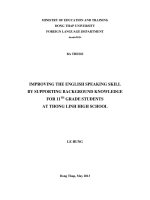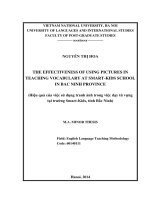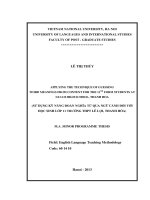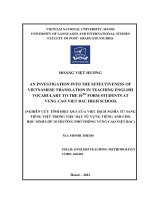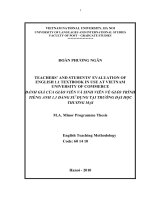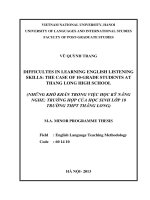The effects of using collocations in teaching english vocabulary for 11th – grade students at son tay high school
Bạn đang xem bản rút gọn của tài liệu. Xem và tải ngay bản đầy đủ của tài liệu tại đây (1.53 MB, 79 trang )
VIETNAM NATIONAL UNIVERSITY, HANOI
UNIVERSITY OF LANGUAGES AND INTERNATIONAL STUDIES
FACULTY OF POST-GRADUATE STUDIES
HOÀNG THỊ DUNG
THE EFFECTS OF USING COLLOCATIONS IN TEACHING
ENGLISH VOCABULARY FOR 11TH-GRADE STUDENTS AT
SON TAY HIGH SCHOOL
Ảnh hưởng của việc sử dụng kết hợp từ tiếng Anh đến việc học từ
vựng của học sinh lớp 11 trường THPT Sơn Tây
M.A. MINOR PROGRAMME THESIS
Field: English Teaching Methodology
Code: 60140111
HANOI - 2016
VIETNAM NATIONAL UNIVERSITY, HANOI
UNIVERSITY OF LANGUAGES AND INTERNATIONAL STUDIES
FACULTY OF POST-GRADUATE STUDIES
HOÀNG THỊ DUNG
THE EFFECTS OF USING COLLOCATIONS IN TEACHING
ENGLISH VOCABULARY FOR 11TH-GRADE STUDENTS AT
SON TAY HIGH SCHOOL
Ảnh hưởng của việc sử dụng kết hợp từ tiếng Anh đến việc học từ
vựng của học sinh lớp 11 trường THPT Sơn Tây
M.A. MINOR PROGRAMME THESIS
Field: English Teaching Methodology
Code: 60140111
Supervisor: Prof. Dr. Nguyễn Quang
HANOI - 2016
STATEMENT OF AUTHORSHIP
I hereby certify that the thesis entitled “The effects of using collocations in teaching
English vocabulary for 11th-grade students at Son Tay high school” is entirely the
result of my own work. The material in this thesis has not been submitted for
assessment in any other formal course. I also accept all the requirements of ULIS
relating to the retention and use of M.A Graduation Thesis deposited in the library.
The research reported in this thesis was approved by ULIS.
Signed:
Date submitted: Hanoi, …./……/2016
i
ACKNOWLEDGEMENTS
To accomplish this study, I am indebted to many people for their thoughtful help.
First and foremost, I would like to acknowledge and thank my supervisor, Prof. Dr.
Nguyen Quang for his valuable guidance, critical feedback and enormous
encouragement, without which my thesis would be far from completion.
I am also grateful to all the lectures of the Graduate Department, University of
Languages and International Studies for their guidance and enthusiasm during my
course.
My sincere thanks go to all English teachers and 11th – grade students at Son Tay High
school.
Finally, I would like to express my thanks to my friends who are willing to help me
during the course. In particular, I find myself indebted to my family, especially my
husband, for their love, care and tolerance when I was in the process of conducting and
writing this thesis.
ii
ABSTRACT
This paper reports a quasi - experimental research that aimed to address the impacts of
collocation teaching on grade 11 students‟ vocabulary improvements. Data for the
study including two proficiency tests and a follow-up questionnaire were collected
from 92 students at Son Tay High school.
In this study, 46 students who followed the conventional vocabulary teaching methods
belong to control group, and 46 others participated in experimental group in which they
are exposed to different strategies related to collocation learning. The scores taken
from the two tests were analyzed using the Statistical Package for the Social
Sciences (SPSS) for Windows version 20.0 software package. The results show that
English collocation teaching has improved the students‟ vocabulary learning. The
findings from the questionnaire indicate that students also have positive attitude
towards the new vocabulary teaching method. They have become well aware of the
collocations‟ importance in language learning. And they have also developed the habit
of learning collocations independently outside the classroom. The findings from the
tests and the questionnaire support each other to affirm the undeniable positive effects
of the collocation teaching. Recommendations for students‟ English vocabulary
improvements and suggestions for further studies are provided on the basis of the
research findings as well.
iii
TABLES OF CONTENTS
Statement of authorship…………………………………………………………………i
Acknowledgements………………………………………………………………….….ii
Abstract………………………………………………………………………….……..iii
Tables of contents……………………………………………………………………...iv
Lists of Abbreviations…………………………………………………………………vii
Lists of Tables, Figures……………………………………………………...………..viii
PART A: INTRODUCTION
1.
Rationale………………………………………...………………………………1
2.
Aims of the study………………………………………………………………..3
3.
Research questions………………………………………………………………3
4.
Scope of the study………………………………………...……………………..4
5.
Significance of the study ………………………………………………………..4
6.
Organization of the study………………………………………………………..5
PART B: DEVELOPMENT
CHAPTER I: LITERATURE REVIEW
1.1.
The role and the importance of vocabulary in ELT…………………...……...…6
1.2.
Collocation ……………………………………………………………………...7
1.2.1. Definition of collocation………………………………………...………………7
1.2.2. Classification of collocation………………………………………...……….…..9
1.3.
Collocation in teaching vocabulary…………………………………………….13
1.3.1. The importance of using collocation in ELT ……………………………….…13
1.3.2. Directions for teaching collocations in English vocabulary …………………..14
1.3.2.1.
Raising the students‟ awareness of the importance of collocations ……….14
1.3.2.2.
Making students be well aware of collocations ……………………………14
iv
1.3.2.3.
Teaching collocations through exercises …………………………………..16
1.3.2.4.
Teaching collocations through context …………………………………….16
1.3.2.5.
Storing collocations ………………………………………………………..16
1.4.
Previous studies………………………………………………………………..17
1.5.
Summary ……………………………………………………………………....18
CHAPTER 2: THE RESEARCH METHODOLOGY
2.1. Research method………………………………………………………………….19
2.2. Context of the research…………………………………………………...……….20
2.3. The study………………………………………...………………………………..20
2.3.1. Participants………………………………………...……………………………20
2.3.2. Data collection instruments……………………………………………….…….22
2.3.2.1. Pretest and Posttest……………………………………………………………22
2.3.2.2. Survey questionnaire………………………………………...………………..23
2.4. Procedure. ………………………………………...………………………………24
2.4.1. The pre implementation phase………………………………………………….25
2.4.2. The implementation phase………………………………………...……………26
2.4.3. The post implementation phase………………………………………...……….30
2.5. Summary………………………………………...………………………………..30
CHAPTER 3: RESULTS AND DISCUSSION
3.1. Results………………………………………...…………………………………..31
3.1.1. Results of Pre-tests………………………………………...……………………31
3.1.2. Results of the effects of collocation teaching on students‟ English vocabulary
learning………………………………………...………………………………………32
3.1.3. Results of questionnaire (Students‟ attitude towards collocation
teaching)………….. ………………………………………...…………………….…..36
v
3.2. Discussion………………………………………...………………………………39
3.2.1. Vocabulary gains as resulting from collocation teaching………………………39
3.2.2. Students‟ attitude towards collocation teaching……………………………...…40
3.3. Summary…………………………………………………...……………………..42
PART C: CONCLUSION AND RECOMMENDATIONS
1. Recapitulation………………………………………...…………………………….43
2. Recommendations ………….………………………………………...…………….44
3. Limitations of the research………………………………………...……….……….45
4. Suggestions for further study………………………………………...……….…….46
REFERENCES
APPENDIX 1: Test scores
APPENDIX 2: Vocabulary Pre-test
APPENDIX 3: Vocabulary Post-test
APPENDIX 4: Key to the vocabulary Pre-test
APPENDIX 5: Key to the vocabulary Post-test
APPENDIX 6: Survey Questionnaire
APPENDIX 7: Survey Questionnaire (Vietnamese version)
vi
LIST OF ABBREVIATIONS
L1
Mother tongue
L2
Foreign language
EFL
English as Foreign Language
ESL
English as Second Language
M
Means
N
Number of Cases or Subjects of the study
p
Probability of chance (indicator of significance)
Std. Deviation
Standard Deviation
SPSS
Statistic Package for Social Science
t
Obtained Value
df
Degree of Freedom
vii
LIST OF TABLES AND FIGURES
Table 1.1
Lexical Collocations Adopted from Benson et al. (1986a)
Table 1.2
Grammatical Collocations Adopted from Benson et al. (1986a)
Table 1.3
Grammatical collocations in G8 group Adopted from Benson
et al. (1986a)
Table 2.1
The main tasks for three implementation phases
Table 3.1
Descriptive statistics for pretest of the Experimental group and
Control group
Table 3.2
Independent Samples T-test of pre-tests
Table 3.3
Results of descriptive statistics of the CG and EG in Pre-test
and Post-test
Table 3.4
Result of independent samples t-test of mean gains of the
Experimental group and Control group after the treatment
Table 3.5
Results of questionnaire on the students „attitude towards
collocation teaching
Allocation of gains by Control group and Experimental group
Figure 3.1
after the treatment
viii
PART A: INTRODUCTION
This chapter provides the background to the study and statement of the problem, the
aims and research questions, the scope as well the significance of the study. It also
outlines the organization of the thesis.
1.
Rationale
In recent years, language teachers and researchers have witnessed a number of changes
in language teaching and learning. The latest developments have tried to get learners
involved in the most effective methods so as to enhance their proficiency in the target
language.
Learning a second language involves the manipulation of four main skills including
speaking, writing, listening and reading, which leads to effective communication. One
key factor in this process is the amount of vocabulary one possesses as vocabulary
forms the integral part of the meaning of any language (McCarthy, 1988). As a result,
vocabulary acquisition is currently receiving special attention in L2 pedagogy and
research, and how learners acquire vocabulary effectively and efficiently and how it
can best be taught are contentious issues in applied linguistics (Lewis, 2006).
Many English learners, despite their quite proficient ability in grammar, reading and
some other L2 skills, are experiencing difficulties in remembering and proficiently
using words that they have learnt. Their lack on vocabulary learning skills can be taken
into account for this obstacle. As can be observed in a certain number of EFL classes,
vocabulary teaching is generally given by classical techniques. Nowadays, linguists all
over the world are studying a variety of effective approaches in vocabulary teaching
and presenting.
New words can be approached from checking their meanings in the dictionary; or
example sentences containing the vocabulary items can be another considering method.
Apart from those, learners can also relate the new vocabularies with the words they
1
have leant to figure out the meaning; or teachers may give verbal explanation of new
vocabulary items mainly in English; and providing synonyms or antonyms of the new
vocabularies is another choice as well. Also, teachers can use pictures, realia, group
work, etc. to convey the words‟ meaning to their students. However, it is evident that
some of these techniques cannot bring about a great deal of vocabulary retention for
learners are not able to make use of presented words in performing academic tasks and
communicative activities (Hedge, 2008).
Collocation is also among these techniques. Within the lexical approach, particular
attention is intended for collocations and expressions that embrace institutionalized
utterances and sentence frames and heads. As Lewis affirms, we attempt to think of
collocations, and to use these collocations in our expressions instead of individual
words. It means, rather than trying to split things into even smaller pieces, we have a
cognizant attempt to see things in larger, more holistic manners (Lewis, 1997).
Therefore, teachers of English should be encouraged to attach more importance to
vocabulary teaching through collocation rather than only the acquisition of grammar
and the use of traditional vocabulary teaching strategies in their classes.
As a foreign language teacher at Son Tay high school, the researcher of the current
study also tries her best to support her students in acquiring accurate and native-like
competence effectively. In her teaching process, she observes and finds out that her
students, who are at grade 11, have to deal with countless difficulties in productive
skills. Examining learners' writing, the researcher could quickly notice the “miscollocations” that are widespread in their written assignments. The similar situation
can also be found out in speaking skill when students know the meaning of each
separate word, but they are still unable to connect these words together naturally and
correctly and use them fluently and constantly. This may be due to their ignorance
of collocations and the interference of the mother tongue which reflect their lack of
proficiency in the target language. In order to overcome these problems, a number of
2
methods can be taken into consider; among them is using collocations. Therefore, it is
crucial to conduct research on the effects of teaching English collocations to enhance
students‟ vocabulary ability. The results gained from this study at Son Tay High school
are expected to contribute to changing Vietnamese EFL teachers and learners‟
traditional perspectives so as to constitute one of the most important parts of
vocabulary teaching.
2.
Aims of the study
This paper aims to find out whether and how teaching vocabulary through collocations
will result in better vocabulary learning than those using conventional techniques. The
research also focuses on investigating the students‟ attitudes towards teaching
collocations. My purpose is to show the contribution of collocations to vocabulary
learning of students in English Foreign Language (EFL) classes at Son Tay high school
in Hanoi. It is hypothesized that learning vocabulary through collocations is an
effective strategy that positively contributes to the development of vocabulary learning;
and students have positive attitudes with regard to learning vocabulary in collocations
rather than that in other vocabulary teaching methods.
3.
Research questions
To satisfy this aim, the current study intended to find answers to the following
questions:
(1) To what extent does using collocations in teaching English vocabulary affect
students’ learning of new words at grade 11 at Son Tay high school?
(2) What are students' attitudes towards teaching collocations?
3
4.
Scope of the study
Though the use of collocation can be applied in different aspects in language teaching
including the macro skills, grammar, vocabulary, etc., the researcher has chosen to
focus only on vocabulary teaching for the fact that collocation is so central to teaching
new words. If a student wants to master a new word completely, it cannot be denied
that he/she has to proficiently use that word in combining with other words or phrases.
A large number of studies prove that presenting new words through collocations result
in a better learning of the words than presenting them using traditional techniques.
Therefore, this research investigates the use of collocation in teaching vocabulary.
In the research conducted, the subject was a small group of grade 11 students who were
non-randomly assigned to a control group and an experimental group. The material
scope used for teaching students during 10 weeks of the investigation is restricted to
English textbook for grade 11.
5.
Significance of the study
Although it is widely acknowledged that collocations are not only indispensable but
also challenging for English language learners, and that they therefore should play an
integral part in L2 teaching at any level, learners' difficulties with collocations have not
been investigated in much detail so far.
The current study primarily focuses on finding out the feasibility of applying
collocations as effectively as possible to L2 teaching in the effort of improving
students‟ method of learning vocabulary. Therefore, it is much to the author‟s
expectation that the results of the current research will help teachers of language
become well aware of what they should do to improve their teaching performance in
class, and students gain more insight into the importance of collocations.
4
6.
Organization of the study
The thesis consists of five chapters, organized as follows:
Part A: Introduction presents the background to the study, the aims of research, the
significance, the scope, and the structure of the thesis.
Part B: Development is organized around three chapters as follows.
Chapter 1: Literature Review discusses relevant theoretical points of view
concerning what can be done and how to develop foreign language learners‟ oral
communication skills. Furthermore, the review of the previous studies related to the
thesis is also provided.
Chapter 2: Research Methodology describes the research method, the data
collection instruments and the information of the participants in the study as well as
the steps to conduct the study.
Chapter 3: Results and Discussion consists of an analysis of the data and a
discussion of the findings.
Part C:
Conclusion and recommendations offers a summary of the findings,
recommendations; limitations of the study and suggestions for further study.
5
PART B: DEVELOPMENT
CHAPTER I: LITERATURE REVIEW
In this chapter, the author will present some theoretical background that proves
necessary in the realization of this research and helps provide related literature to the
study. First, the studies related to the L2 teaching and learning of vocabulary,
especially the application of collocation use in teaching English vocabularies that some
prominent researchers all over the world have conducted and what they have found out
will be reviewed systematically with the purpose of providing the basis of the
investigating issue.
1.1.
The role and the importance of vocabulary in ELT
Learning any foreign language involves the proficient manipulation of all macro skills
including speaking, writing, listening and reading, which leads to effective
communication. One capital factor in this process is the amount of vocabulary one
possesses as vocabulary forms the biggest part of the meaning of any language
(McCarthy, 1988). Indeed, vocabulary acquisition is currently receiving much attention
in second language pedagogical field and research, therefore how learners acquire
vocabulary effectively and efficiently and how it can best be taught are contentious
issues in applied linguistics (Lewis, 2006).
There have been a great number of different approaches related to language learning,
each with different perspectives on vocabulary (Richards & Rodgers, 2001). It is the
fact that learning a language should not be reduced to only learning vocabulary, but it
is also true that “no matter how well the student learns grammar, no matter how
successfully the sounds of L2 are mastered, without words to express a wide range of
meanings, communication in an L2 just cannot happen in any meaningful way”
(McCarthy, 1990). Language teaching methodologies sometimes have attached great
6
importance to vocabulary learning, and sometimes it has been neglected (Schmitt,
2000). In practice, grammar and pronunciation are at the core of language learning,
while vocabulary is ignored in most foreign language classes (Fernández, Prahlad,
Rubtsova, & Sabitov, 2009). Nowadays it is widely accepted that vocabulary learning
is one of the essential elements of both acquiring native language and learning a
foreign language (Morra & Camba, 2009). Learning vocabulary is considered as a
crucial element to help learners obtain a high level of proficiency in the target language
by a large number of theoreticians (Boers & Lindstromberg, 2008). In addition, special
attention has been paid to foreign language vocabulary acquisition by those involved in
foreign language learning (Zu, 2009). It is also believed that those possessing a large
and varied range of vocabulary are competencies in terms of foreign language
communication, which is one of the important aspects of language learning
(McCrostie, 2007).
For all intents and purposes, vocabulary should be considered as an integral part of
learning a foreign language since it leads the way to communication. Such as writing
and reading, vocabulary knowledge is one of the components of language skills
(Nation & Waring, 1997). And of course, not only teachers, but also students need to
be made well aware of the significance of vocabulary to fulfill their English language
competence.
1.2.
Collocation
1.2.1. Definition of collocation
Although collocation has become the subject of linguistics only recently, there have
been a number of ideas what “collocation” is by different linguists. According to Bahns
(1993), “collocation is a term which is used and understood in many different ways”.
First, a look at some typical ones among the varied definitions that researchers and
linguists have brought out is taken. Many scholars believe that the term is first used in
7
1981 by Palmer, an English linguist and teacher, who defines “collocation” as “a
succession of two or more words that must be learned as an integral whole and not
pieced together from its component parts”. Some others, however, regard Firth, a
British linguist, as the one who sets the foundation of collocation and develops a
lexical and the most traditional approach to this phenomenon. He introduces the term
meaning by collocation as a new mode of meaning of words and distinguishes it from
both the “conceptual or idea approach to the meaning of words” and “contextual
meaning”. One of Firth‟s revolutionary concepts is to perceive lexical relations as
syntagmatic rather than paradigmatic ones. He takes “dark night” as an example. His
analysis is that one of the meanings of night is its collocability with dark, and one of
the meanings of dark is its collocability with night. Thus, a complete analysis of the
meaning of a word would have to include all its collocations. According to Firth
(1957), “collocations of a given word” are defined as “statements of the habitual or
customary places of that word.”
Halliday (1966), one of Firth‟s followers, considers collocations as examples of word
combinations. By the examples for his argument: “he argued strongly” and “the
strength of his argument”, which are grammatical transformations of the initial
collocation “strong argument”, he states that collocation cuts across grammar
boundaries.
According to Moon (1997), collocations can be defined in many ways, and some
of these definitions are as follows: collocations are words that occur together with
high frequency and refer to the combination of words that have a certain mutual
expectancy. “The combination is not a fixed expression but there is a greater
than
chance likelihood that the words will co-occur” (Jackson, 1988:96). Also,
McCarten (2007) states that the way in which two or more words are typically
used is generally called collocation. As cited from Oxford Collocations Dictionary
(2002), “collocation is the way words combine in a language to produce natural-
8
sounding speech and writing”. Richards et al (1992) suggests a more specific way to
define: “Collocation is the way in which words are used together regularly. Collocation
refers to restrictions on how words can be used together, for instance, which
prepositions are used with the particular verbs of which verbs and nouns are used
together”.
1.2.2. Classification of collocation
Based on the core characteristics of collocations, a wide variety of ways to classify
collocations have been put forward by different linguists and lexicographers. In fact,
there is much effort to categorize the individual collocations as part of a general
scheme since the nature of collocations make it challenging to make a thorough
distinction among various kinds of collocations.
Benson et al. (1986a), mostly the pioneers as for the classification of collocations,
categorize collocations systematically into two major groups: lexical collocations and
grammatical collocations. Lexical collocation could be made up of nouns, adjectives,
verbs, or adverbs, like “warmest regards”, “strictly accurate”, etc. There are seven
subgroups of lexical collocations whose structures and examples are given below:
Table 1.1. Lexical Collocations Adopted from Benson et al. (1986a)
Type
Pattern
Example
A
verb (meaning creation or activation)+ noun
(pronoun or prep. phrase)
compose music;
make an impression
B
verb (meaning eradication or nullification)+
noun
revoke a license;
demolish a house
adjective + noun
strong tea; a rough estimate
noun + verb
bees buzz; bombs explode
noun1 of noun2
a pack of dogs; a herd of
C
D
E
9
buffalo; a herd of buffalo
F
adjective + adverb/ adverb + adjective
sound asleep;
hopelessly addicted
verb + adverb
anchor firmly; argue
heatedly
G
The other group, grammatical collocation, consists of a dominant word, such as a noun,
an adjective, or a verb, and a preposition or grammatical structure like an infinitive or a
clause. Benson et al. (1986a) further categorized the grammatical collocations into
eight small groups, labeled as G1 to G8, as being illustrated clearly in the following
table:
Table 1.2. Grammatical Collocations Adopted from Benson et al. (1986a)
Type
G1
G2
G3
G4
G5
G6
G7
G8
Pattern
Example
noun + preposition
love for
noun + to inf.
They made an attempt to do it
noun + that clause
An agreement that she would
represent us in court
preposition + noun;
By accident, to somebody‟s
advantage
adjective + preposition
Fond of; angry at;
predicate adjective +to
inf.
adjective + that clause
She is easy to please
19 verbal patterns of
English
10
She was afraid that she would
fail the examination.
Table 1.3. Grammatical collocations in G8 group Adopted from Benson et al.
(1986a)
Type
Pattern
Example
G8 (1)
S + V + Od to Oi
S + V + Oi + Od
He sent a book to his brother.
He sent his brother a book.
They returned the book to her.
G8 (3)
S + V + Od to Oi
(do not allow the dative
movement transformation)
S + V + Od for Oi
S + V + Oi + Od
G8 (4)
S + V + Prep + O
S + V + O + Prep + O
He came by train.
We invited them to the meeting.
S + V to V
They began to speak.
S + modal V + V
He had better go.
He must go.
S + V + Ving
They enjoy watching television.
S + V + O to V
She asks me to come.
S + V + O + bare V
She heard them leave.
S + V + O + Ving
I caught them stealing apples.
S + V possessive Adj + Ving
We noticed his leaving early.
S + V (+ O) + that clause
They admitted that they were wrong.
S + V + O to be C
We consider her to be very capable.
S+V+O+C
She dyed her hair red.
S+V+O+O
We bet her ten pounds.
S + V (+ O) + Adverb
He carried himself well.
S + V (+ O) + wh-word
He wants what I want.
G8 (2)
G8 (5)
G8 (6)
G8 (7)
G8 (8)
G8 (9)
G8 (10)
G8 (11)
G8 (12)
G8 (13)
G8 (14)
G8 (15)
G8 (16)
G8 (17)
She bought a shirt for her husband.
She bought her husband a shirt.
11
G8 (18)
It + V + O to V
It + V + O + that clause
It surprised me to learn of her decision.
It surprised me that our offer was rejected.
G8 (19)
S + V + C (adjective or
noun)
She was enthusiastic. The flowers smell
nice.
In terms of structure, Bahn (1993) shares the same classification with Benson et al.,
apart from adding another type namely long collocations which consist of more than
two components. This way of classification is of many linguistic researchers‟ and
teachers‟ interest.
That is a quite special type of collocation, as can be seen in the instances get access to,
take good care of, etc. Flexible word pairs include collocations between subject and
verb, or verb and object, any of the intervening words may occur between the words of
collocations.
Hill (as cited in Michael Lewis, 2000: 63) produces another classification of
collocations according to strength into four categories: unique collocations, strong
collocations, weak collocations and medium-strength collocations. First, there are
unique collocations which are fixed and cannot make way for any other items. As
examples, he gives the two collocations “foot the bill” and “shrug your shoulders”.
The two collocations are unique because the verbs “foot” and “shrug” are not used with
any other nouns. In the second place, there are strong collocations like “trenchant
criticism” and “rancid butter”. These are not unique but not many possible collocates
can be used to substitute it. Thirdly, weak collocations relates to collocations with a
wide variety of collocates, as adjectives “long”, “short”, “cheap”, “expensive”,
“good” or “bad” can combine with many different nouns, for instance an expensive
shirt, a long shirt, etc. These combinations are “more predictable” and easy to the
majority of students. Finally, the fourth type is medium-strength collocations; for
example “holds a conversation” and “a major operation”. Hill thinks that students are
concerned with this type which is neither strong nor weak.
12
Distinctions are made between grammatical collocations and semantic collocations
by Kathleen and Dragomir in their paper named Collocations. They affirm that
grammatical collocations often contain prepositions, including paired syntactic
categories such as verb+preposition (e.g. come to, put on), adjective+preposition (e.g.
afraid that, fond of), and noun+preposition (e.g. by accident, witness to). In these cases,
the open-class word is called the base and determines the words it can collocate with,
the collocators. Semantic collocations are lexically restricted word pairs, where only a
subset of the synonyms of the collocator can be used in the same lexical context.
1.3.
Collocation in teaching vocabulary
1.3.1. The importance of using collocations in ELT
In ELT, many English language teachers prefer emphasizing grammar to vocabulary in
their class because grammar is a finite system, whereas vocabulary is not (Sheehan,
2004). And when the teaching of vocabulary items is taken into account, most teachers
only prefer to use classical vocabulary teaching techniques such as synonyms,
antonyms, mother tongue translation and definition. As a result, students do not make
any effort to reach the word meaning and it is inevitable that they probably will not
remember the meaning of the new words, or even worse, they will not be able to use
the new words they have learned even if they remember the meaning because they do
not know the suitable collocates. Therefore, it is not surprising when Hill (1999, cited
in Richard & Rodgers, 2001) states that most learners with “good vocabularies” have
problems with fluency because their collocational competence is very limited. And
what is more, in his research in 1981, Channel claims that learners may fail to realize
the potential of words they know well because they only use them in a limited number
of collocations of which they are sure. For those facts, it is a widely accepted idea
among linguists that collocation is an indispensable part of knowledge of second
language acquisition and they are essential to non-native speakers of English in order
to speak or write fluently and accurately (Jaén, 2007).
13
It is easy to realize how complicated the area of collocation is, and also, how crucial it
is due to its frequent use in daily life‟s communication in general and in linguistics in
particular. Collocations are advantageous in helping English learners enhance their
accuracy, fluency, and naturalness.
1.3.2. Directions for teaching collocations in English vocabulary
1.3.2.1. Raising the students’ awareness of the importance of collocations.
Collocations require to be taught so that the learners would be aware of them because
they would help learners not only to understand vocabulary but also to link ideas more
effectively when they write or speak. Numerous linguists and language teachers have
underscored the remarkable significance of collocation consciousness-raising in ELT.
Teaching collocations would provide learners with a helpful device in producing
language. It could facilitate the productive tasks by making it easier, more precise and
more natural and native-like. Conzett (2000) underlines that students should be taught
the word Collocation itself. This is because students have already formed in their mind
the collocations in their mother tongue without consciousness. Thus it is not
challenging for them to understand what collocation means, and it helps save much
time by using this term in class. Actually, some people may argue that if students do
not know the concept, they can still learn and use collocations, however when they
have knowledge of what collocations are, students would be more aware of the
existence and significance of collocations, and of course, they can learn how to develop
their knowledge of collocations independently (Woolard, 2000).
1.3.2.2. Making students be well aware of collocations
Teaching collocations and avoiding the interference of the mother tongue
Foreign language learners tend to transfer negatively already-known words and group
of words from L1 into the target language because of interference. They do translate
expressions either consciously or unconsciously from L1 into L2 due to
14
"interlanguage" or first language translation, as stated by many researchers such as
Selinker (1969), which is a considerable problem that disrupts learners‟ performance in
the target language. Therefore, for the reason that a common collocation in students‟
native language is not necessarily the same in English and vice versa, it is indispensible
for teachers to make their learners notice the difference between collocations of each
language and think in the target language as far as possible in order to avoid translating
the L1 collocations into the L2, since these translations would lead to errors in writing
or speaking.
Highlighting and noticing
The vocabulary acquisition could benefit from developing the learners‟ noticing in
teaching collocations by drawing their attention towards some words or elements that
are always found together. One way of making students do so is highlighting, which
could be achieved by underlining the collocation, coloring it, writing it in italics or in
bold. These are effective ways to draw the learners‟ attention to collocations in order to
notice them. In Morgan‟s perspectives (cited in Lewis, 2000), the learners will not
make progress unless they are trained to notice words that go together. This training, he
affirms, will increase their fluency in speaking and writing.
Another way to develop among students is noticing. As noticing is an interesting
factor in memorizing knowledge in long-term memory, there are several factors
that make it stronger. According to Lewis (2000: 117), noticing should be reinforced
by homework, cooperation, involvement, and motivation. Other important factors that
foster noticing are repetition and “meaningful contexts” as claimed by Kennedy (2003)
“the provision of systematic, repeated exposure to
collocations
in
meaningful
contexts lies at the heart of the teaching enterprise.” As a general comment,
noticing collocations facilitates their acquisition but it is “a complex process” in which
teachers should be attentive enough to give the guidance to draw students‟ attention.
15


